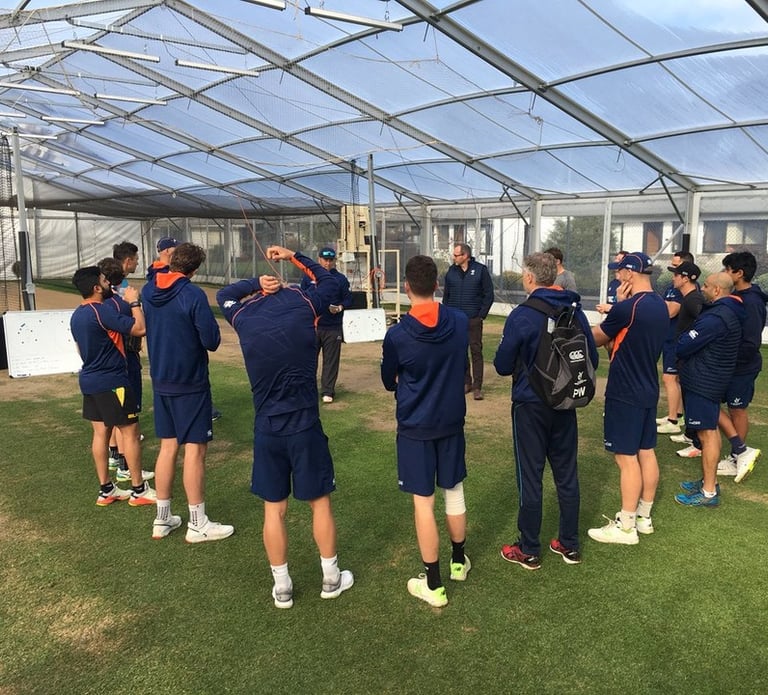The best coaching I’ve ever had
Elly shares an unforgettable experience with renowned coach Mike Shrimpton at NZC High Performance Centre. Elly recounts how Shrimpton’s deep insight into his mindset, confidence, and batting struggles helped him unlock new potential on the field. Dive into this candid narrative of personal growth, resilience, and mental breakthroughs that transformed Elly's approach to batting.
Marc Ellison
11/26/20186 min read


NZC High Performance Centre, Lincoln, September 2005.
I was coming to the end of the second year in the NZC Junior Academy.
The schedule involved three one-week residences during the school holidays at NZ Cricket Headquarters at Lincoln, 20 minutes south of Christchurch.
The coaches involved were Dayle Hadlee, Mike Shrimpton, Glenn Turner, Gary Stead and Jason Mills.
My understanding of the art of coaching as an 18-year-old was rather limited and little did I know that the 65-year-old-bloke who could hit slip catches like a specialist and could peel off any leg-spin variation on cue, was in fact the best man manager of the lot.
I had no idea at the time, but ‘Shrimpo’ was quietly observing me over the six weeks I spent at NZC HQ across a two-calendar year period.
Lacking confidence
It was Thursday, the second last day of my sixth and final camp as a Junior Academy member, and we’d just finished an outdoor net session on the grass nets beside the magnificent Bert Sutcliffe Oval.
I was in the middle of one of my many confidence slumps.
The previous season I had attended my third National Under 19 Tournament and averaged 15 on the flattest batting tracks in the country.
I hadn’t made more than 50 during the course of the season as I experienced the aggressive nature of Premier men’s cricket for the first time and I thought I had lost my ability to play long innings.
I was searching for answers within myself and it appeared that no coach at the camp had an answer for my woes other than to encourage me to hit the large volume of balls that we did that week and every week we spent at Lincoln.
After I’d finished batting, Shrimpo came over to talk to me.
The ‘chat’
Over an hour later, he’d finished.
He systematically broke my character down into its different parts and explained to me my own fears and frustrations and why they were happening.
I barely said a word.
He talked to me about what he’d witnessed from my behaviour and body language over the previous 18 months and demonstrated that he’d managed to work me out as a human being.
There was nowhere to hide.
He identified that the mistakes I was making while batting were largely mental and that I had the ability to pull myself out of the slump and build myself up to be the player everyone expected me to be.
He touched on his own failings as a batsman and that he saw a number of similar characteristics in regard to how I was going about things.
Even something obscure, like the fact that I often seemed to be sick – he was referring to a frame of mind that was bordering on the negative or pessimistic.
Paralysis via analysis
The search for perfection was part of the issue, he suggested.
In the hope of getting everything right - head, hands, feet, contact point etc. – I was guilty of finishing every stroke I played, even the good ones, on a negative note.
He offered some solutions.
The most memorable one was the power of visualisation.
He encouraged me to think back to when I’d played memorable innings’ in the past and to recall as much about that day as I could – how much sleep I’d had, what I’d had for breakfast, what I’d done the morning before the match, what I’d done in the warm up, what I’d eaten for lunch, any thoughts or feelings I had on the day, my approach to batting, what type of bowlers I was facing, the pace of the pitch, what sounds I remember hearing and what strokes I played.
And, my task was to absorb as many of the good feelings from those innings as possible to help rebuild my confidence.
The idea that if I’d done it before, I could do it again.
Another solution was to find a way to care a little less about the process of hitting the ball and more about the outcome.
“It’s not how, it’s how many.”
An ‘awakening’
Never before and certainly not since has anyone been able to sit me down and absolutely nail everything about my character traits and habits and the impact it’s having on my life.
To add to the remarkable nature of it all, at that point in time, I’d barely spent more than 10 minutes at a time with Shrimpo.
I was too busy drooling over Glenn Turner whenever he was in attendance.
Shrimpo’s record wasn’t impressive enough for me to crack a cricket semi.
Turns’ record was.
Turns had 100 first-class hundreds under his belt, so I wanted as much time with him as I could get.
In the aftermath of my discussion with Shrimpo, I began asking the guys around me at the Academy what they thought about at the moment the ball left the bowler’s hand.
As I learned from my classmates, the ideal mental state at the moment of release was a completely clear mind.
‘Gee’, I thought to myself, ‘when have I ever had that?’
A lack of trust
Without realising it, I had never grasped the concept that the art of batting is about accessing your instincts.
I didn’t realise that training is all about honing or enhancing your instincts, so that when you enter the heat of battle, you select the appropriate stroke to best deal with the delivery bowled.
I had fallen into a habit of relying on my strong front foot play and inadvertently pre-meditating full-pitched deliveries.
I began re-evaluating my approach to the game.
Here’s what I decided to change:
1. Add visualisation to my weekly routine to remember how good I could be.
2. Remember that batting is a fun activity and in the grand scheme of life, getting out is relatively insignificant.
3. Practice a wider range of stroke-play.
4. Build trust in my ability to rely on my instinct by training this way.
5. Work on clearing my mind at the moment the bowler releases the ball.
These were all foreign ideas to me, but they required a substantial change in mentality if I was to take them on board and build a more resilient weekly routine.
A change in approach
I started to focus on having more fun at training by practicing shots like the slog sweep against the spinners and walking down the wicket to loft the seamers over the top of the in-field.
I began using music to relax myself before each innings and then letting memorable songs capture my attention as I batted; allowing the tune, beat and lyrics to occupy my sub-conscious like never before.
Songs in my head also helped me to clear my mind by the time the bowler released the ball.
While working at a meat processing plant as part of my student holiday job along-side the likes of future Blackcaps Mark Craig, Mitchell McClenaghan and Colin Munro, I used the long monotonous days of packaging sheep liver, heart and tripe to occupy my mind with my best innings.
I imagined as much as I could recall about my best scores, and did it as often as I could, just as Shrimpo had encouraged me to.
So much so that sometimes I had no idea whether I was reaching the correct weight for each bag of delicious offal.
The outcome
I began batting with more freedom.
I took on riskier options instinctively and my confidence grew every time it came off.
When it didn’t come off, I didn’t allow my thought process to turn negative and just went back to nailing my weekly process.
I made 77 for the Auckland Under 19s against an Auckland A team featuring future Blackcap Andy McKay in a warm up match ahead of our National Under 19 tournament – despite not registering a fifty for my club team, Howick Pakuranga.
That particular innings did my confidence a world of good heading into the tournament that would decide which 15 players would represent New Zealand at the 2006 Cricket World Cup.
I went on to score 400 runs at an average of 100 at the tournament at Lincoln in January and secured my spot in the squad; being named captain was the cherry on top.
For the first time in my career, I realised that I could play with more freedom, trust my instincts and have success.
None of it would have been possible without that hour-long discussion with Mike Shrimpton.
It wouldn’t be the last time Shrimpo would have an impact on my career, but it certainly was the most significant.
Appreciation
Shrimpo’s foresight to observe me for 18 months and wait for the right time to strike with his advice, showed his mastery of the art of coaching.
‘They’ say that the hardest thing to do as a coach, mentor or parent is to sit on information and say nothing.
Well, he basically did that for 18 months (while often adding value technically during our ball striking sessions).
I’ve learned a lot from Shrimpo’s approach to coaching.
The way he built rapport with his players.
How he used his incredibly dry sense of humour to lighten the mood at exactly the right time.
While he nearly always appeared so deep in thought, he also had a unique way of enjoying himself, for example how he was able to bowl every leg-spin variation on cue with the perfect seam rotation.
The way he could pick out whichever slip fielding position you asked for during slip catching practice, seemingly regardless of the throw.
I’m extremely grateful to have his influence live on with me today, some three-and-a-half years after his passing.
What a truly great man he was.
Vale Mike Shrimpton.
P.S. I’d love to hear from those of you who experienced Shrimpo’s magic.
